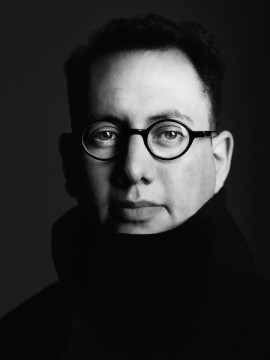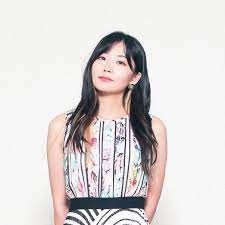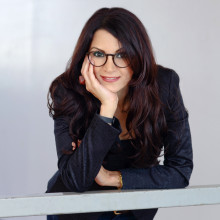
Get the latest news
Subscribe to receive updates from the School of Data Science.

Refik Anadol (b. 1985, Istanbul, Turkey) is an internationally renowned media artist, director, and pioneer in the aesthetics of machine intelligence. He currently resides in Los Angeles, California, where he owns and operates Refik Anadol Studio and RAS LAB, the Studio’s research practice centered around discovering and developing trailblazing approaches to data narratives. Anadol is also teaching at UCLA’s Department of Design Media Arts from which he obtained his Master of Fine Arts.
Anadol’s body of work addresses the challenges, and the possibilities, that ubiquitous computing has imposed on humanity, and what it means to be a human in the age of AI. He explores how the perception and experience of time and space are radically changing now that machines dominate our everyday lives. Anadol is intrigued by the ways in which the digital age and machine intelligence allow for a new aesthetic technique to create enriched immersive environments that offer a dynamic perception of space.
By proposing the possibility of “post-digital architecture,” Anadol invites his audience to imagine alternative realities by redefining the functionalities of both interior and exterior architectural elements. He tackles this by moving beyond the integration of media into built forms and translating the logic of a new media technology into art and design.
Residing at the crossroads of art, science, and technology, Anadol’s site-specific three-dimensional data sculptures and paintings, live audio/visual performances, and immersive installations take varied virtual and physical forms. Entire buildings come to life, floors, walls, and ceilings disappear into infinity, breathtaking aesthetics take shape from large swaths of data, and what was once invisible to the human eye becomes visible, offering the audience a new perspective on, and narrative of their worlds.
The primary thread that runs throughout Anadol’s groundbreaking visualizations of the unseen world is data. For Unsupervised at the Museum of Modern Art, New York, Anadol posed an alternate understanding of modern art by transforming the metadata of MoMA’s vast collection into a work that continuously generates new forms in real-time. For Quantum Memories at the National Gallery of Victoria, 200 million photos of Earth and its landscapes, oceans and atmosphere were used to visualize an alternate reality of nature. For Sense of Space at the 17th International Architecture Exhibition – La Biennale di Venezia – approximately 70 terabytes of multimodal MRI data, including structural, diffusion (DTI) and functional (fMRI) scans of people ranging from birth to nonagenarians was used to design the human brain-inspired artwork. Archival photographic data of our universe from the archives of NASA/JPL was the driving force behind Machine Memoirs: Space, Istanbul’s most visited exhibition ever. Machine Hallucination: NYC harnessed 113 million publicly available images of New York City to envision the near future of a storied city. For WDCH Dreams, 100 years of the Los Angeles Philharmonic’s digital archives were tapped to inspire the visuals projected onto Frank Gehry’s iconic building. Oakland’s Sense of Place used real-time environmental data such as wind, temperature, and humidity as well as invisible communication signals from Bluetooth, Wifi and LTE to inform the work. At Berlin’s Latent Being, the visitors interacted with the artwork and themselves provided real-time data for the artificial thinking process. Charlotte Airport’s Interconnected, Anadol transformed real-time airport statistics such as arrivals/departures, baggage handling systems and ground shuttle transportation into an ever-changing suite of abstract form, color, and simulated texture.
Refik Anadol ’s global projects have received a number of awards and prizes including the Lorenzo il Magnifico Lifetime Achievement Award for New Media Art, Microsoft Research’s Best Vision Award, iF Gold Award, D&AD Pencil Award, German Design Award, UCLA Art+Architecture Moss Award, Columbia University’s Breakthrough in Storytelling Award, University of California Institute for Research in the Arts Award, SEGD Global Design Award, and Google’s Artists and Machine Intelligence Artist Residency Award.
Anadol’s site-specific audio/visual performances have been featured at iconic landmarks, museums and festivals worldwide, such as the 17th International Architecture Exhibition – La Biennale di Venezia, The Museum of Modern Art (New York), The Centre Pompidou, Pinakothek der Moderne, EMMA Museum, Art Basel, Haus der elektronischen, Kunsthalle Praha, Palazzo Strozzi, Casa Batlló, National Gallery of Victoria, Walt Disney Concert Hall, Hammer Museum, Dongdaemun Design Plaza, Artechouse, The Portland Building, Daejeon Museum of Art, Florence Biennale, Art Basel, OFFF Festival, International Digital Arts Biennial Montreal, Ars Electronica Festival , l’Usine | Genève, Arc De Triomf, Zollverein | SANAA’s School of Design Building, santralistanbul Contemporary Art Center, Outdoor Vision Festival, Istanbul Design Biennial, Sydney City Art, and Lichtrouten, among many others.
Refik Anadol Studio, an early adopter of blockchain technology, has utilized NFT sales to raise over $5 million U.S. dollars for charitable organizations including St. Jude Children’s Research Hospital, The Alzheimer’s Foundation and UNICEF. Machine Hallucinations — Space: Metaverse, a physical exhibition in Hong Kong and correlating NFT collection, brought together the studio’s richly diverse works to the Metaverse. Presented in collaboration with Sotheby’s, the NFT collection contained yet another groundbreaking approach to media arts by presenting the first immersive NFT. Living Architecture: Casa Batlló, inspired by Antoni Gaudi’s building in Barcelona, Spain, became the first artwork from the studio to be auctioned by Christie’s. The piece was displayed on a giant media screen in New York’s iconic Rockefeller Plaza with a simultaneous live projection mapping performance on the actual facade of Casa Batlló which was viewed by an enormous crowd of nearly 50,000 people. As the only NFT offered during Christie’s 21st Century Evening Sale which also included physical works by Banksy, Gerhard Richter, and Jeff Koons, among others, Living Architecture: Casa Batlló set records for the next generation of young artists.
Refik Anadol Studio comprises designers, architects, data scientists, and researchers from diverse professional and personal backgrounds, embracing principles of inclusion and equity throughout every stage of production. Studio members originate from 10 different countries and are collectively fluent in 15 languages. The Studio’s internship program also demonstrates a strong commitment to mentoring young people from a variety of personal experiences, values, and world views.
A pioneer in his field, and the first to use artificial intelligence in a public artwork, Anadol has partnered with teams at Google, Microsoft, NVIDIA, NASA/JPL, Intel, IBM, Siemens, Epson, MIT, UCLA, Harvard University, Imperial College, Stanford University, and UCSF, to apply the latest, cutting-edge science, research and technologies to his work.

Stephen Baek is an applied geometer, scientist, and entrepreneur. He studies the space of shapes using machine learning. Baek’s educational background is in mechanical and aerospace engineering.
Prior to joining UVA in 2021, he was an Assistant Professor at the University of Iowa, where he taught courses on deep learning. There, he also founded and directed the Visual Intelligence Laboratory, which conducts fundamental research in computational geometry, vision, and machine learning. Baek’s research interests include geometric data analysis, geometric deep learning, scientific machine learning, and data-driven design.
Baek’s published research is extensive, including “Deep learning for synthetic microstructure generation in a materials-by-design framework for heterogeneous energetic materials” and “Deep segmentation networks predict survival of non-small cell lung cancer.”
Baek holds a PH.D. in Mechanical and Aerospace Engineering from Seoul National University and a B.S. in Mechanical and Aerospace Engineering from Seoul National University.

Yoon Chung Han is an interaction designer, multimedia artist, and researcher. Her researches include data visualization, biometric data visualization and sonification, new interface for musical expression, and mobile user experience design. She studied Graphic Design and Interaction Design at Seoul National University (under Prof. Suzung Kim), and achieved two Master degrees at SNU and Design | Media Arts in UCLA (under Prof. Casey Reas) She was a graduate student researcher and teaching assistant at Experimental Visualization Lab under Prof. George Legrady, and a Visiting Researcher / PhD Student at the SENSEable City Lab in MIT in Cambridge, MA. She taught interaction design and computer programming for artists and designers at the Academy of Art University, University of San Francisco and California State University, Fullerton. She recently completed her PhD at the Media Arts and Technology, UC Santa Barbara.
Currently she is an Associate Professor in Graphic Design at the Department of Design in the San Jose State University, and SIGGRAPH 2023 Art Gallery Chair.

Mona Kasra is a new media artist, interdisciplinary researcher, and associate professor of digital media design at the University of Virginia (UVA).
Her research trajectory involves exploring the confluence of media technologies, art, and culture, reflecting on the impact of emerging media on personal, political, and creative expression, and experimenting with affordances of such media for artistic practices of performance and installation. Currently, she is researching representational, affective, and creative possibilities of immersive media, and designing experimental and performative experiences in Virtual Reality (VR/360). One of her newest projects is in collaboration with music prof Luke Dahl where they will explore how motion capture, spatial audio, and interactive XR environments can represent and transmit embodied cultural practices.
Kasra is committed to transdisciplinary and collaborative modes of scholarship. Her work has thrived in programs such as Virtual and Augmented Reality for the Digital Humanities Institute (V/AR-DHI), Digital Societies and Social Technologies Institute (DSST), Humanities, Arts, Science, and Technology Advanced Collaboratory Scholars (HASTAC). She regularly present my research at national and international conferences and have published in journals such as New Media & Society, The Communication Review, Journal of Dance Education, Media and Communication.
Her research and practice are fundamentally hybrid and informed by her background in art, design, technology, and media studies. Her design projection design, projection mapping, interactive media installations for traditional theatre, immersive theatre, and live performance. She is a member of DWZ, a Dallas-based collective dedicated to post-disciplinary, place-based explorations of new, old and yet to be revealed forms of performance. Her artwork has been exhibited in galleries and online exhibitions, and she has juried, curated, and programmed for various film festivals and art exhibitions. In 2016, Kasra served as Conference Chair at ACM SIGGRAPH, undertaking an engaged role in the strategic planning, leading, and managing of the world’s largest, most influential annual conference on the theory and practice of computer graphics and interactive techniques.
At the University of Virginia, Kasra lectures and teaches courses on new media art, projection design, integrated interactive media, and immersive media (VR/360). She is currently a faculty fellow at New College Curriculum and the Institute for Advanced Technology in the Humanities (IATH) at UVA.
Kasra was born in Tehran, Iran. She holds a Ph.D. in Arts, Technology, and Emerging Communication from the University of Texas-Dallas, an M.F.A. in Video/Digital Art from California State University Northridge, and a B.A. in Graphic Design and Visual Communication from the Art University of Tehran.
Subscribe to receive updates from the School of Data Science.